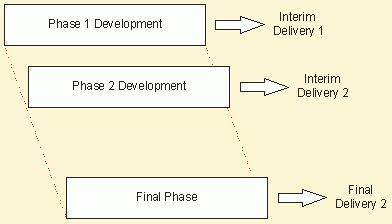SDLC Model: Progressive Development Lifecycle Model

A common problem with software development is that software is needed quickly, but it will take a long time to fully develop. The solution is to form a compromise between time scales and functionality, providing "interim" deliveries of software, with reduced functionality, but serving as a stepping stones towards the fully functional software. It is also possible to use such a stepping stone approach as a means of reducing risk.
The usual names given to this approach to software development are progressive development or phased implementation. The corresponding lifecycle model is referred to as a progressive development lifecycle. Within a progressive development lifecycle, each individual phase of development will follow its own software development lifecycle, typically using a V or waterfall model. The actual number of phases will depend upon the development.
Each delivery of software will have to pass acceptance testing to verify the software fulfils the relevant parts of the overall requirements. The testing and integration of each phase will require time and effort. Therefore, there is a point at which an increase in the number of development phases will actually become counter productive, giving an increased cost and time scale, which will have to be weighed carefully against the need for an early solution.
The software produced by an early phase of the model may never actually be used; it may just serve as a prototype. A prototype will take short cuts in order to provide a quick means of validating key requirements and verifying critical areas of design. These short cuts may be in areas such as reduced documentation and testing. When such short cuts are taken, it is essential to plan to discard the prototype and implement the next phase from scratch, because the reduced quality of the prototype will not provide a good foundation for continued development.

0 Comments:
Post a Comment
<< Home